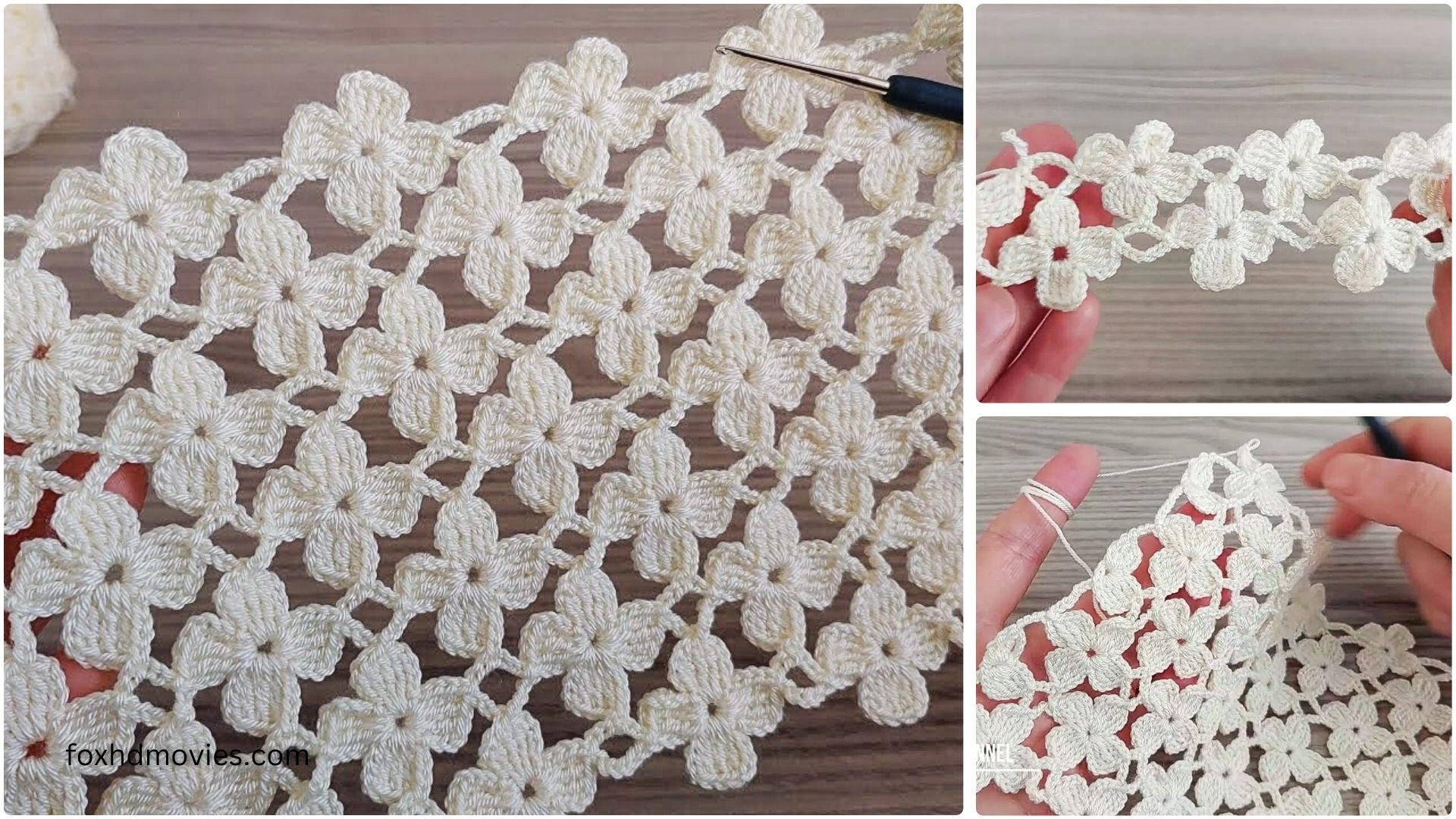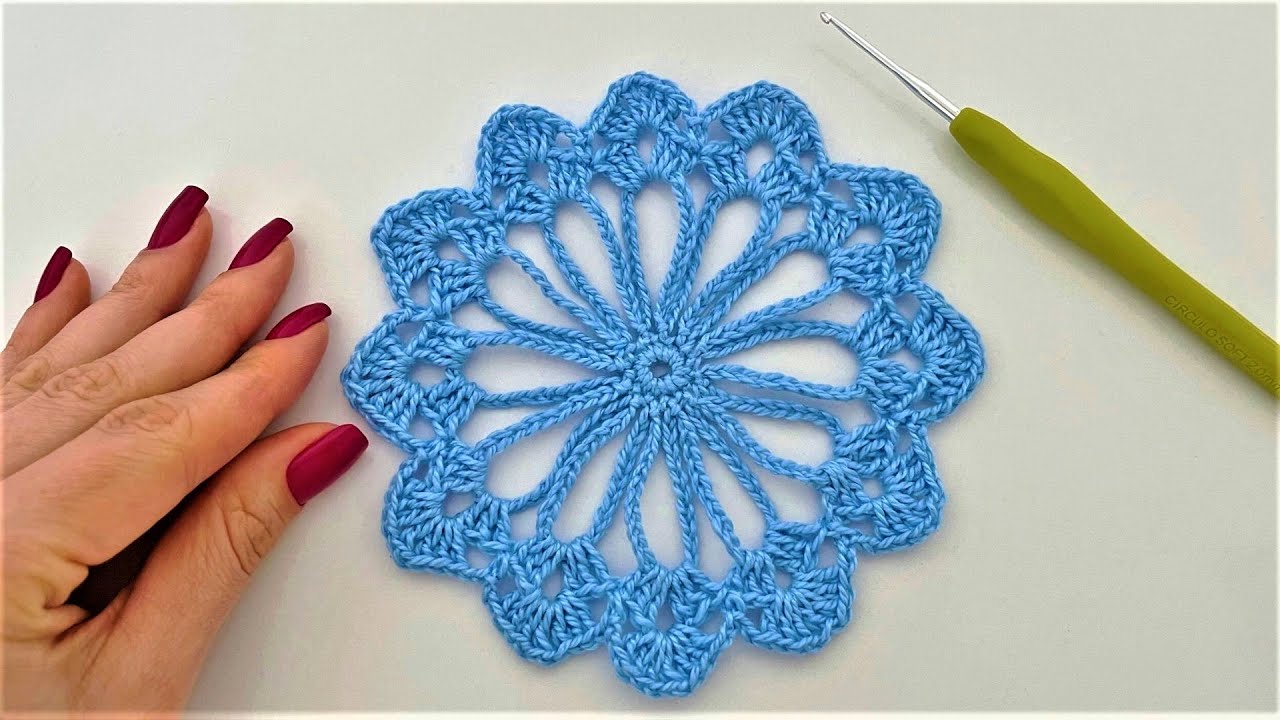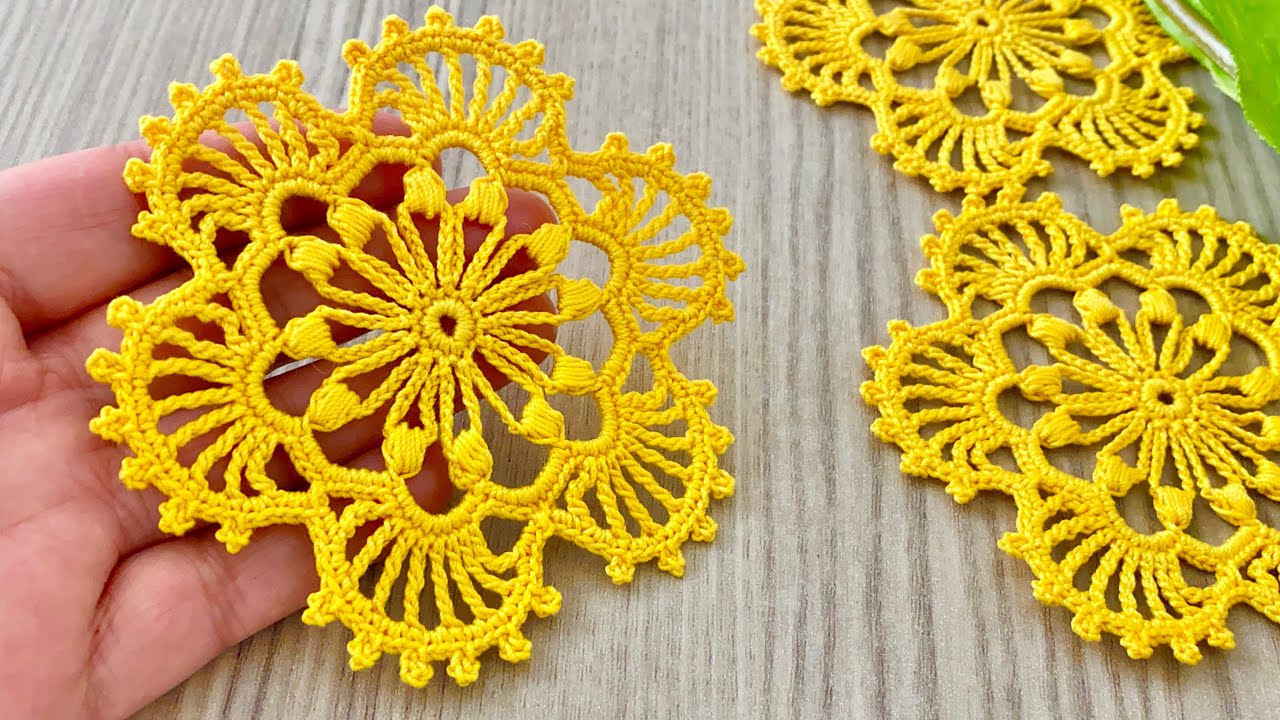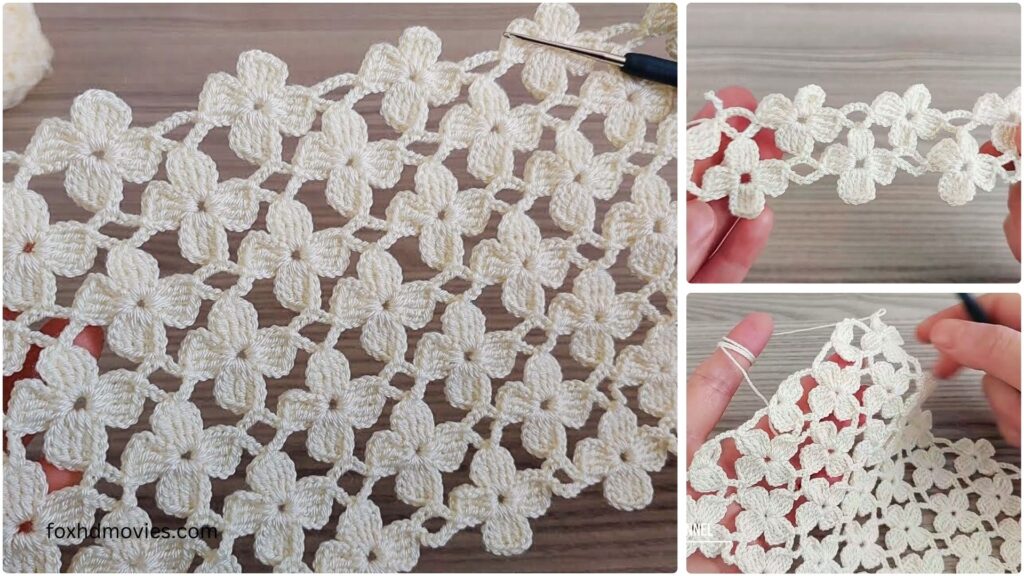
Imagine draping yourself in a delicate shawl adorned with graceful floral patterns, created with the timeless technique of filet crochet. This “Etol Shawl” (often referring to a lightweight, rectangular shawl or stole) is designed to be very easy, making it perfect for beginners who want to dip their toes into filet crochet, or for experienced crocheters looking for a relaxing and rewarding project.
Filet crochet uses simple chains and double crochets to create “open” and “closed” squares, forming beautiful lace-like designs. Our floral motif will emerge naturally as you follow the pattern.
Skill Level: Easy (Great for adventurous beginners!)
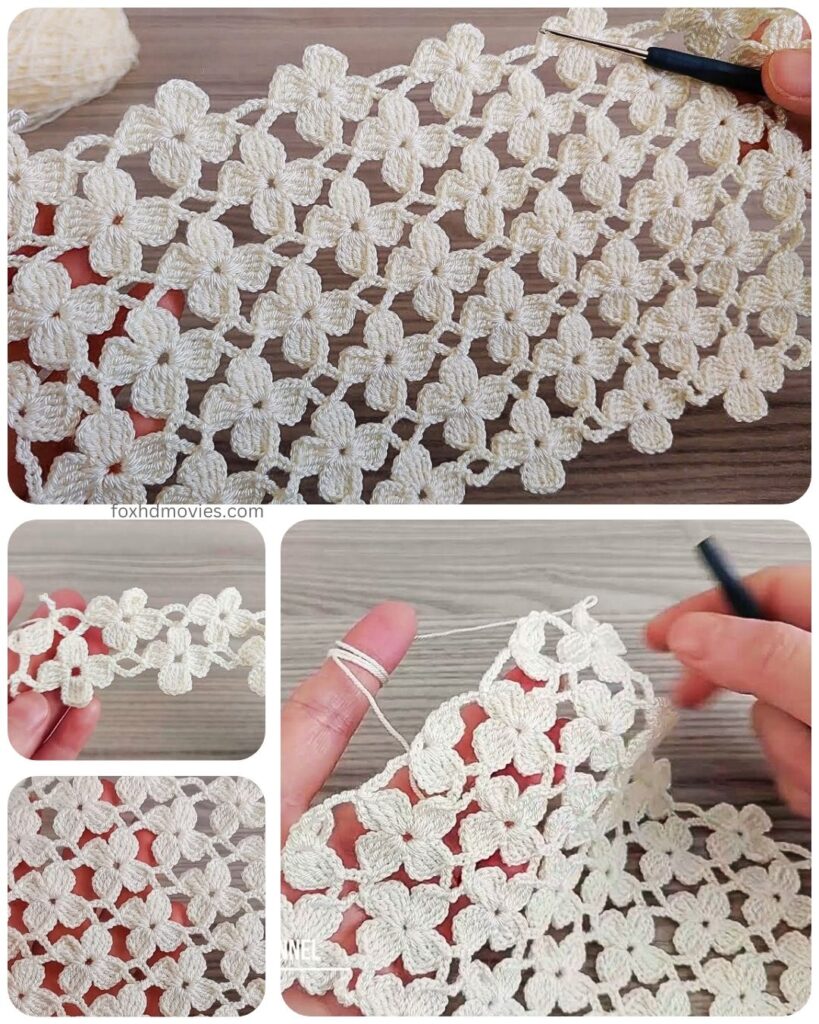
Materials:
- Yarn: DK (Light Worsted) or Sport weight yarn. For a delicate drape, choose a natural fiber like cotton, linen, or a cotton blend. You’ll need approximately 500-700 yards, depending on your desired length and gauge.
- Tip: Lighter colors will show the filet pattern more clearly.
- Crochet Hook: Size G/6 (4.0 mm) or size needed to obtain gauge.
- Yarn Needle: For weaving in ends.
- Scissors
Gauge:
- 10 “open squares” (ch 2, skip 2, dc) and 10 rows = approximately 4 inches x 4 inches (10 cm x 10 cm).
- Note: Gauge is important for the pattern to look proportionate. Make a small swatch to check your tension.
Finished Size (Approximate):
- Length: 60-70 inches (150-175 cm)
- Width: 18-20 inches (45-50 cm)
- Adjustable! Instructions for altering length and width are included.
Abbreviations (US Crochet Terms):
- ch: chain
- st(s): stitch(es)
- sl st: slip stitch
- dc: double crochet
- sk: skip
- sp: space
- ea: each
- beg: beginning
Understanding Filet Crochet Basics:
- Open Square (OS): dc in the next st, ch 2, sk 2 sts.
- Closed Square (CS): dc in the next 3 sts. (Or dc in next st, dc in each of next 2 ch, dc in next st if working over an open square). Essentially, it’s 3 dc.
- Turning Chain: Ch 3 at the beginning of a row counts as the first dc.
The Flower Filet Pattern Chart:
This pattern will primarily be worked by following a simple chart. Each square on the chart represents either an “open square” (empty) or a “closed square” (filled). We will use a repeating motif to create the flower design.

Let’s assume our flower motif is 8 squares wide. You’ll repeat this motif across your desired width.
- Number of Starting Chains: To determine your starting chain, multiply the number of desired squares across by 3, then add 1.
- For example, if you want your shawl to be 40 squares wide: (40 squares * 3) + 1 = 121 chains.
- For our example, let’s aim for a width that accommodates 5 full flower motifs, plus an edge: (8 squares per flower * 5 flowers) + 2 squares for ends = 42 squares total. So, (42 squares * 3) + 1 = 127 chains.
The Flower Motif (Repeat as many times as needed across the row):
| Row | Square 1 | Square 2 | Square 3 | Square 4 | Square 5 | Square 6 | Square 7 | Square 8 | | :– | :——- | :——- | :——- | :——- | :——- | :——- | :——- | :——- | | 1 | OS | OS | OS | OS | OS | OS | OS | OS | | 2 | OS | OS | OS | OS | OS | OS | OS | OS | | 3 | OS | OS | OS | CS | CS | OS | OS | OS | | 4 | OS | OS | CS | CS | CS | CS | OS | OS | | 5 | OS | CS | CS | OS | OS | CS | CS | OS | | 6 | OS | CS | OS | CS | CS | OS | CS | OS | | 7 | OS | CS | CS | OS | OS | CS | CS | OS | | 8 | OS | OS | CS | CS | CS | CS | OS | OS | | 9 | OS | OS | OS | CS | CS | OS | OS | OS | | 10 | OS | OS | OS | OS | OS | OS | OS | OS | | 11 | OS | OS | OS | OS | OS | OS | OS | OS |
Legend:
- OS: Open Square (dc, ch 2, sk 2)
- CS: Closed Square (dc, dc over next 2 ch, dc for ch-2 sp; or dc in next 3 dc for dc block)

Instructions for the Shawl:
Foundation Row: Ch 127 (or your desired number of chains: (number of squares wide * 3) + 1).
Row 1 (Right Side): Dc in the 4th ch from the hook (counts as first OS). *Ch 2, sk 2 ch, dc in the next ch.* Rep from * across the row. You should have 42 Open Squares (OS). Turn.
Important Note for Following the Chart:
- When working Right Side (RS) rows (odd-numbered rows starting with Row 1, 3, 5, etc.), you will read the chart from Right to Left.
- When working Wrong Side (WS) rows (even-numbered rows starting with Row 2, 4, 6, etc.), you will read the chart from Left to Right.
Let’s follow the chart for one repeat of the flower. Remember your full row will be multiple repeats of the 8-square motif, plus any edge squares.
Row 2 (WS): Ch 3 (counts as first dc). Work OS across the entire row. (Your first 2 rows are all open squares). Turn.

Row 3 (RS – Start of Flower): Ch 3. Work OS until you reach the start of your first flower motif (e.g., 2 OS for the edge). Now follow the chart for Row 3: OS, OS, CS, CS, OS, OS, OS. Work CS by placing a dc in the next dc, and a dc in each of the next 2 chs (over the OS below). Continue across the row, repeating the 8-square motif. End with any remaining OS for the edge. Turn.
Row 4 (WS – Flower continues): Ch 3. Work OS until you reach the start of your first flower motif. Now follow the chart for Row 4 (reading Left to Right): OS, OS, CS, CS, CS, CS, OS, OS. Remember that a CS over a CS from the previous row is simply 3 dc. A CS over an OS from the previous row is dc in the dc, then 2 dc in the ch-2 sp. An OS over a CS is dc in 1st dc, ch 2, sk 2 dc. Continue across the row, repeating the 8-square motif. End with any remaining OS for the edge. Turn.
Continue following the chart for Rows 5-11, paying attention to reading the chart direction (RS vs. WS) and how to form OS and CS over the previous row’s stitches.
After Row 11: You have completed one full flower motif! To repeat the pattern, simply go back to Row 2 of the chart and continue from there.
Repeating the Pattern:
- Continue repeating Rows 2-11 of the chart until your shawl reaches your desired length.
- For a typical etol shawl, you’ll likely want multiple full flower repeats along the length.
- End your shawl with Row 10 or Row 11 (all OS) for a symmetrical look.

Finishing:
- Fasten off, leaving a long tail.
- Weave in all ends neatly using your yarn needle.
- Blocking (Highly Recommended!): Gently wash or wet your shawl, then carefully pin it to a flat surface (like foam blocking mats) according to your desired dimensions. This will open up the lace pattern and give your shawl a beautiful, professional drape. Let it air dry completely.
Video tutorial
Customizing Your Shawl:
- Width: To make your shawl wider or narrower, simply adjust the number of starting chains. Ensure your starting chain allows for full repeats of your flower motif (the 8 squares) plus any desired edge squares. The total number of chains should be (number of squares wide * 3) + 1.
- Length: To make your shawl longer or shorter, simply work more or fewer repeats of the Rows 2-11 pattern.
- Yarn Choice: Experiment with different yarn weights for different effects. A lace weight yarn will create a very delicate and airy shawl, while a worsted weight will be more substantial. Adjust your hook size accordingly.
And there you have it! A beautiful and easy Crochet Flower Filet Etol Shawl, perfect for adding a touch of handmade elegance to any outfit. Enjoy the process of watching the flowers bloom with every row! Happy crocheting!
